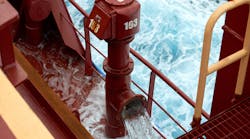Latest from Technology Innovations
The Future of Thermal Insulation: New Spray Coatings Handle Corrosion Challenges
The World Corrosion Organization estimates that corrosion costs the global economy $2.2 trillion annually. Industrial plants have long relied on traditional mechanical insulation systems that use mineral wool and metal jacketing to insulate heated tanks, pipes, and related equipment. These systems are still crucial as they serve dual purposes: they protect personnel and enhance energy efficiency. Yet, they're not without their flaws. The tendency for these materials to absorb moisture reduces their insulative efficiency and sets the stage for corrosion under insulation (CUI), a costly risk.
The industry's response to this widespread problem is evolving. Recent advancements in paint and coatings technology have led to the development of an enhanced silicone-based, spray-on insulation coating. This innovative solution is engineered to overcome the shortcomings of previous products by offering increased hydrophobicity, greater film thickness, and better temperature resistance. The advanced coating also provides direct-to-metal corrosion protection, eliminating the need for a primer and setting a new standard in insulation technology.
A Leap in Application and Installation Efficiency
Installation of traditional insulation is notoriously cumbersome and labor-intensive, particularly in large-scale applications. It often involves extensive scaffolding, precision cutting to fit complex shapes, and the risk of improper sealing. Exposure to water can lead to saturated insulation, drastically reducing thermal performance and guaranteeing the onset of CUI. In severe cases, the added water weight can cause the insulation to shift, collapse, or bulge out of its metal jacketing, further diminishing its effectiveness.
Acknowledging these challenges, the industry has focused on faster, more efficient application methods. Traditional waterborne acrylic or epoxy spray-applied coatings are limited in coating thickness and temperature resistance. Their application process is time-consuming, requiring multiple layers to achieve the desired thickness and protection. Conversely, the application testing of the next-generation, silicone-based, spray-applied insulation coating has shown that it doesn't need many coats. The coatings can be applied in thicknesses of up to 250 mils (6.35 mm) per coat. Depending on the specific application requirements, only one or two coats are needed, substantially cutting down the time and cost of the insulation process. Despite the reduced number of layers, it can achieve a higher total coating thickness of 500 mils (12.7 mm).
The silicone-based coating also has a rapid cure time as it can reach dry-to-touch status in a few hours or less at 77°F (25°C). It can also be applied to hot substrates, allowing assets to remain in service during application—a big advantage over traditional methods that require operational shutdowns.
Combat Corrosion
Another notable benefit of this silicone-based coating is its ability to mitigate CUI effectively. CUI is a critical issue that can lead to expensive maintenance, shutdowns, and incidents resulting in injuries or fatalities. The advanced coatings have exceptional corrosion protection capabilities, as demonstrated in stringent salt spray and water condensation tests according to ISO standards, showing no signs of deterioration under harsh conditions.
In addition to mitigating CUI, the new coating offers greater durability and safety. Its high-temperature resistance makes it suitable for a larger market segment, particularly for pipes operating above 350°F (177°C). Thermal testing indicates that the coating can endure continuous and cyclic temperatures up to 500+°F (260°C), surpassing the capabilities of other coatings. Even after exposure to dry heat at 500°F (260°C) for 100 hours, the coating showed less than 5% mass loss, confirming its durability.
Field applications and lab tests also verify its low thermal conductivity and hydrophobic nature. Compared to fibrous insulation materials, the coating absorbs significantly less moisture, enhancing insulation performance and operational efficiency. The ability to maintain safe-to-touch surfaces even at elevated temperatures further underscores the coating's protection benefits.
Look Ahead: The Future of Insulation
The advent of silicone-based insulation coatings marks a milestone in the quest for more resilient and efficient insulation solutions. By providing a faster, hotter, and drier approach to insulation challenges, these coatings are not just an alternative but represent a revolutionary stride forward for the industry. They stand poised to redefine insulation practices, offering a pragmatic and potent defense against the ever-present threat of corrosion, ultimately leading to safer and cost-effective operations.
About the Author
Nicole Rakers
Nicole Rakers is a product development supervisor for the PPG Protective and Marine Coatings business, focused on product development for atmospheric protection and thermal management. She has more than 10 years of experience developing innovative solutions for customers, taking projects from conception through the stage-gate process to launch and post-launch support. To learn more about PPG Protective and Marine Coatings, visit here.















